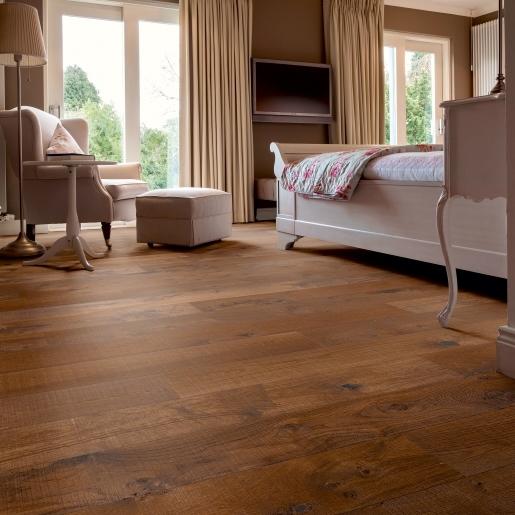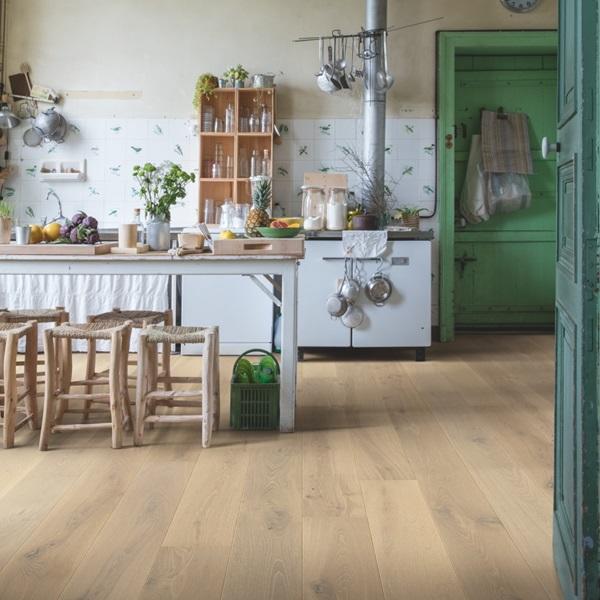Wooden Flooring is 100% natural and appears as a timeless classic if maintained properly, but if both solid wood and engineered wood flooring looks like real wood, what is actually the difference and how do you know what will work best in your home? Read this guide from Flooring Village on solid wood vs engineered wood flooring.
Solid wood flooring is a classic choice from homes that has been used for hundreds of years. However, we always recommend engineered wood flooring for durability, flexibility and the same beautiful look. Read more to learn why engineered wood flooring is becoming the more popular choice.
At Flooring Village, we have a massive collection of wood flooring, including loads of leading brands such as Egger and Woodpecker engineered wood flooring as well as styles including herringbone engineered parquet. Explore our website to find more!
What is Engineered Wood Flooring?
Engineering wooden flooring has multiple layers, ranging from three to twelve, glued together using the hot press method. These sheets are placed in opposite directions to provide greater strength and stability, more than your normal solid wooden flooring.
There are three essential and constant layers in every engineered wood floor:
The solid layer
This is the top most layer which is visible to the eyes and is made of solid wood. This forms the plank surface. The thick top layer is called as ‘Lamella’ and the thickness may range from 2 to 6mm. Depending on the wood you purchase, the lamella is sanded and finished in a certain way and comes in a wide variety of woods. This is the part that is most customisable to create the effect you want in your home.
The core layer
The core layer is a supportive baseboard which has high-density fibreboard, usually softwood or plywood. They are used to groove the joint system otherwise act as a ‘tongue of the floor’ and creates the main part of the board, giving it strength and solidity.
The backboards
Backboards form the base of the flooring, which is firm and makes it stable without slipping from the cup. This type of layered wood can be guaranteed up to 30 years and there is no possibility for it to shrink, swell or be affected by moderate humidity.
Understanding what engineered wood is helps understand the way it contrasts to solid wood.
While engineered wood is made of at least three layers of different types of wood, giving it additional stability and strength. Real wood flooring is made from a single plank of solid wood. This means it has limitations.
Advantages of Engineered vs Solid Wood
The below advantages are of standard engineered wood and things may vary from one kind of wood to another as all kinds of engineered wood differ in quality and price.
Stability
A good reason to choose engineered wood over solid wood is due to its stability. A quality engineered wood board is made up of 10 layers of multi-laminated plywood and these layers provide strength to the wooden flooring. The very best quality engineered wood can even resist 30 minutes of flame and will not delaminate.
Moisture Resistance
Woods are generally hygroscopic, which means they absorb moisture very easily. This may result in the wood contracting or expanding due to them absorbing and releasing moisture, leading to staining or cracking.
The climate of your home will therefore impact real wood flooring over its lifetime and you might noticed gaps appearing between the boards or at the edges of the room. The layers within engineered wood, on the other hand, is constructed to give more leeway in terms of movement. The floor can come into contact with moisture and react to it without permanent damage to the wood. It means that it’s more reliable for all climates.
Installation
Engineered wooden flooring has different types of joint that allow you to fit the wooden floor. There is no need for nails or any adhesive materials to install them. This guileless process is simple while they are floating over the underlay and can be fixed using click options. This can cut down your labour and budget heavily compared to solid wood.
Underfloor Heating
Underfloor heating is becoming an increasingly popular choice in modern homes, helping to cut down on heating bills and keep your house toasty. Solid wood flooring can’t withstand the heat generated by underfloor heating and will warp, making it inappropriate for homes with underfloor heating systems.
However, that doesn’t mean you can’t get a beautiful real wood floor. The additional stability provided by engineered wood means it can withstand changing heat conditions without warping. It’s the perfect way to get a real wood floor even if you have underfloor heating.
The Same Wood Look
Ultimately, both solid wood and engineered wood flooring provide the same beautiful, real wood appearance with the key difference being in the stability of the material. Engineered wood flooring is more stable and durable, able to withstand changes in moisture and heat conditions without any effect to the material.
If you’re looking for a highly durable wood floor, choose an engineered floor from Flooring Village. We have a massive range of different choices!

